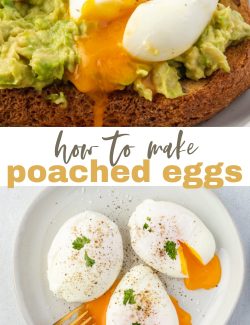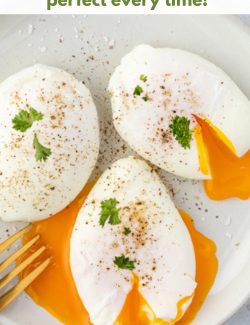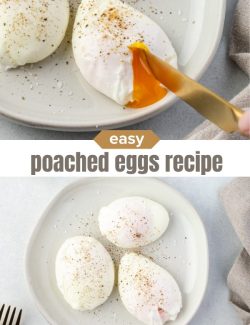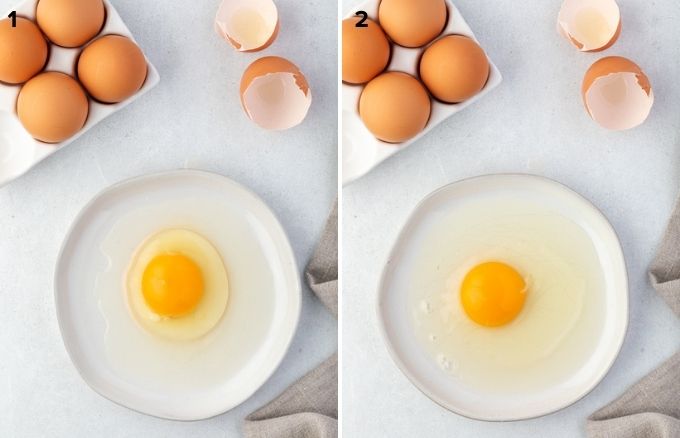Poached Eggs Recipe
Learn how to make Poached Eggs perfectly every time with my simple tips! They’re so easy to prepare, and the recipe includes cooking times for soft, medium and hard poached eggs to please everyone in the family!
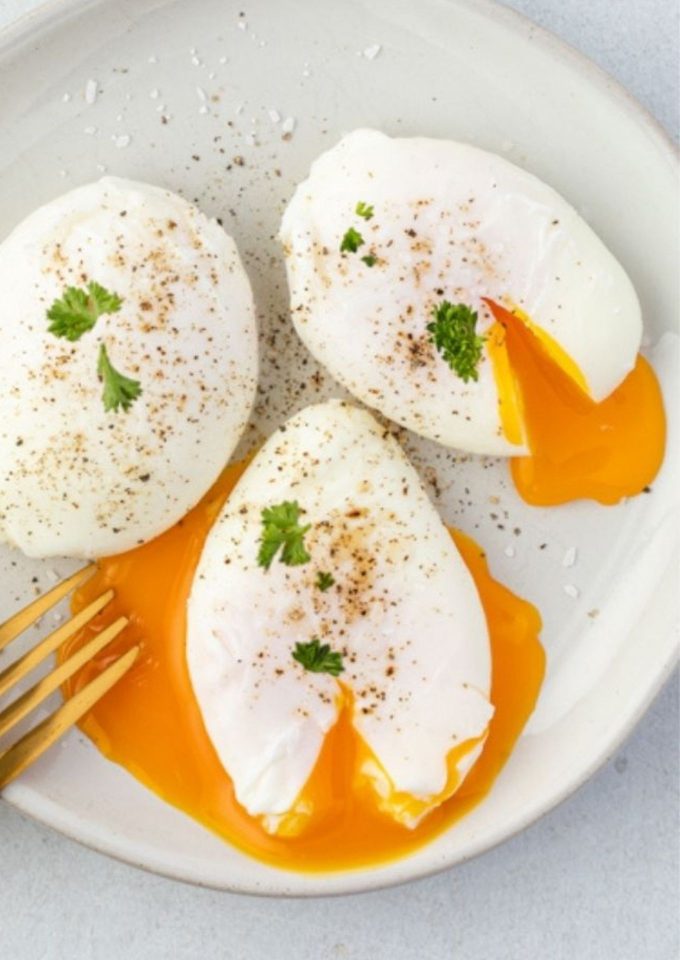
Poached eggs remind me of my childhood. My mom would make them for me every now and then, especially when I wasn’t feeling well. I loved cutting into the yolk to watch it spill out, and I always dipped my toast in it. 🙂
My mom used an egg poacher to achieve a perfectly shaped egg white, but no special equipment is needed for this recipe.
I know a lot of people find the concept of making poached eggs intimidating, but this recipe will show you that making them is just as easy (if not easier) than making hard boiled eggs.
It’s amazing how something so simple can make your meals feel fancy and elegant!
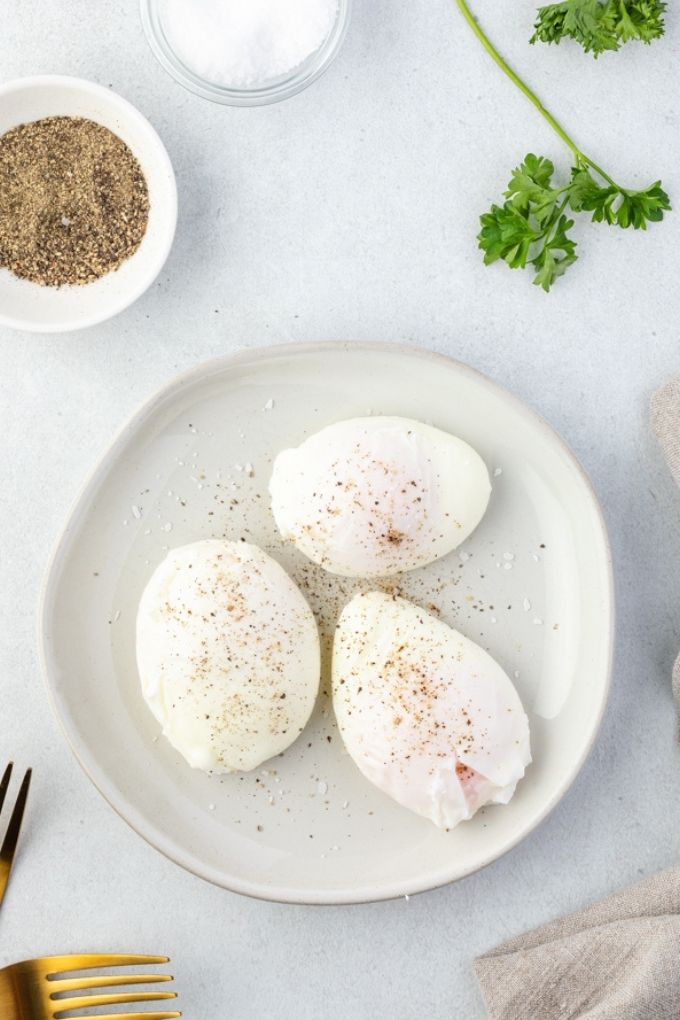
Why you’ll love this recipe:
- This poached eggs recipe is the foolproof way to make them perfectly every time.
- They feel fancy, but they’re so easy to make.
- Recipe includes cooking times for soft, medium and hard poached eggs to please everyone in the family.
- They’re versatile and work well served over avocado toast, in eggs benedict or even grain bowls.
Recipe ingredients
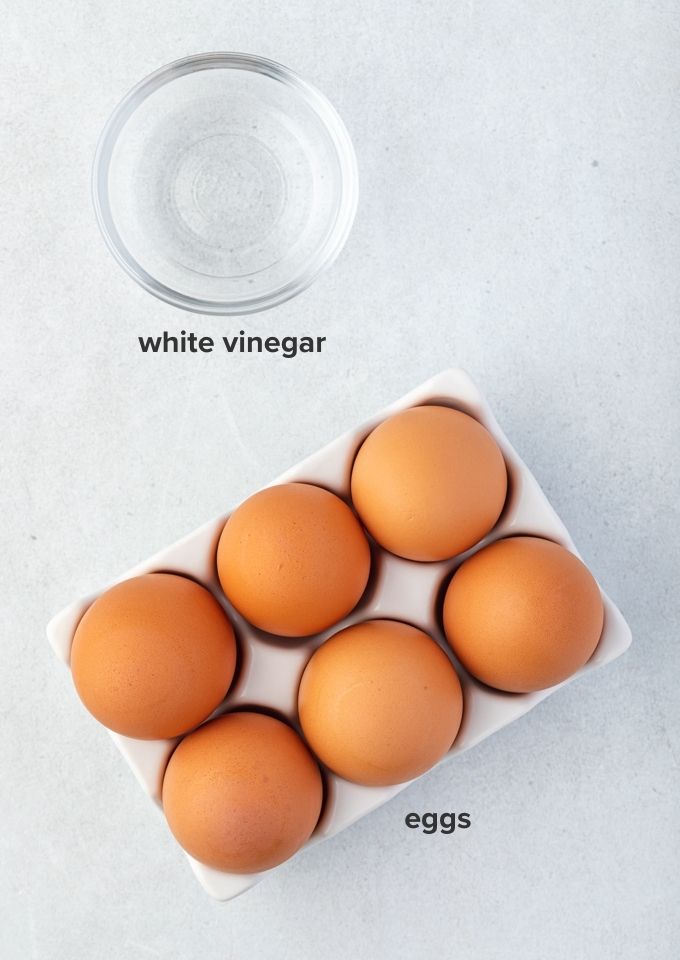
- Eggs. The cooking time for this recipe is based on large eggs, so if you use a smaller or larger size egg, be sure to decrease or increase the amount of cooking time accordingly.
- Vinegar. White distilled vinegar is preferred in this recipe as it will not change the color of the egg and it has a subtle flavor that does not come through. The vinegar is essential to the egg white keeping its shape and prevents those pesky wispy egg whites.
How to poach an egg
The simple steps below will show you how to poach an egg quickly and easily. The process is not intimidating in the slightest, and no special equipment is necessary.
See the recipe card below for full instructions.
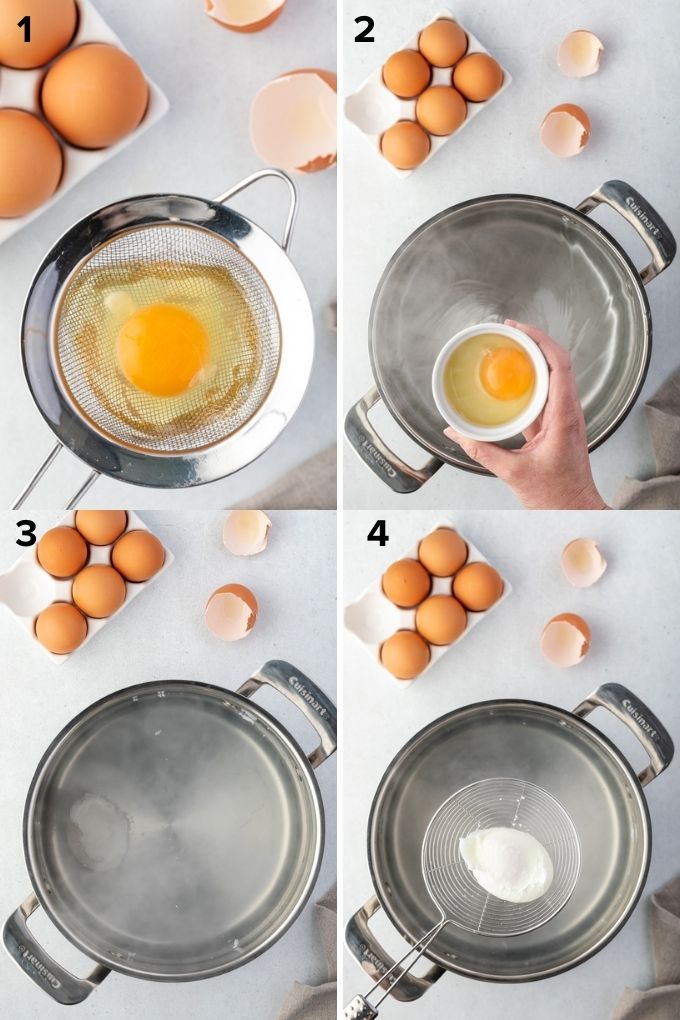
- Strain the egg in a mesh strainer to remove the more liquid part of the egg white and place the egg in a ramekin or small bowl.
- Pour the egg into a pot of gently simmering water.
- Cook the egg for 3 minutes for soft poached (see the recipe card for medium and hard poached cooking times).
- Remove the egg from the pot with a slotted spoon.
How long to poach an egg
Now that you know how to poach an egg, it’s important to know how long to poach them depending on the desired doneness.
If you’re like me and you’re all about that runny yolk, soft poached is the way to go. Medium poached is for those in between, and hard poached is for those that don’t prefer yolk that runneth over. 🙂
The photo below shows a comparison between soft, medium and hard poached eggs (left to right), and the cooking time for each is below.
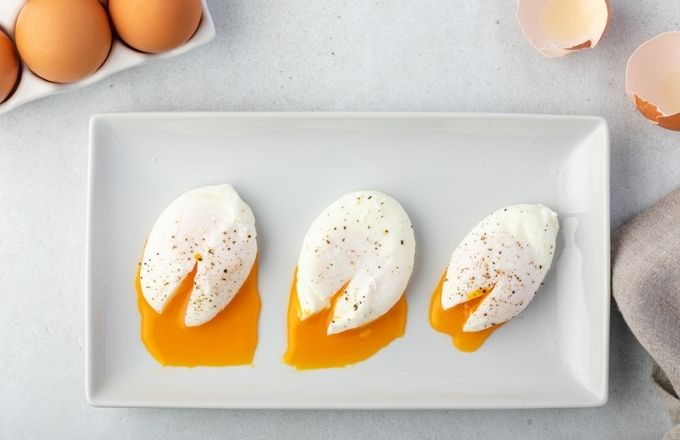
- Soft poached eggs: 3 minutes
- Medium poached eggs: 4 minutes
- Hard poached eggs: 5 minutes
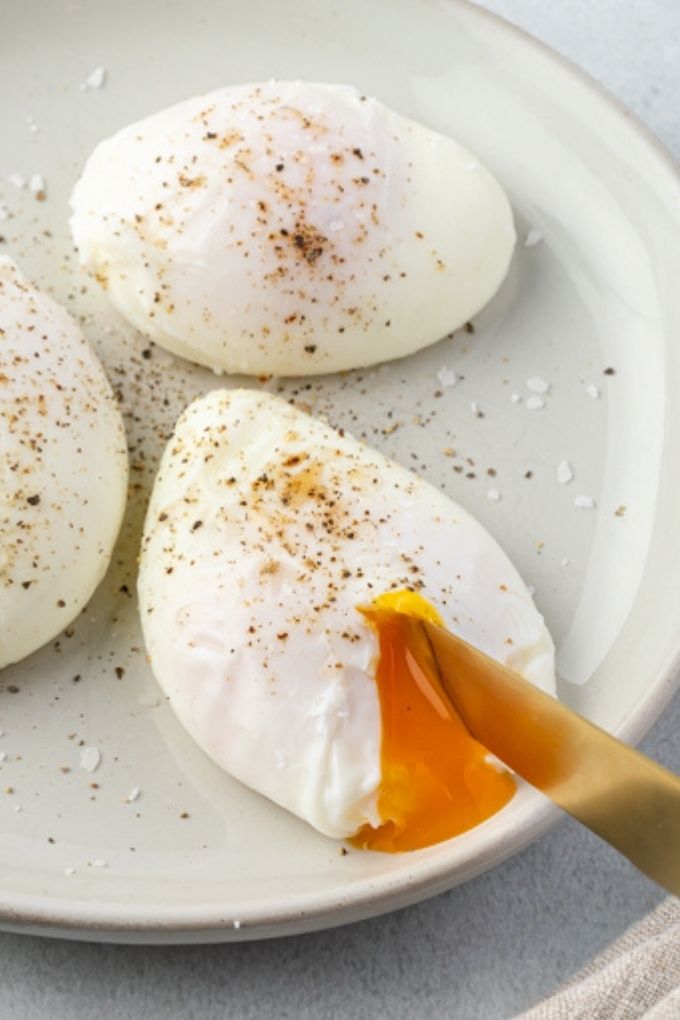
FAQs
Adding distilled white vinegar to boiling water is essential to poaching eggs as it helps the egg white congeal and reduce the amount of wispy egg white.
Straining the eggs will remove the outermost liquid part of the egg white, which is what causes an excessive amount of wispy egg whites.
The photos below show a comparison of the amount of liquid egg white in a fresh egg (Figure 1) versus an older egg (Figure 2). The fresh egg white is distinct in shape, which will result in a perfectly shaped poached egg once it has been strained.
I recommend using fresh eggs for this recipe as they will hold their shape much better.
I’ve found that the eggs held their shape better when I poached one at a time, but you can certainly poach up to 2 at a time. Be sure to crack them both into small bowls and drop them into the center of the swirling water one after the other.
Yes! Once they’re cooked, simply cool on a plate then store in a bowl of cold water in the refrigerator for up to 2 days. Reheat them by placing them in a bowl of warm water and let stand until heated through. Remove with a slotted spoon, season with salt and pepper and serve.
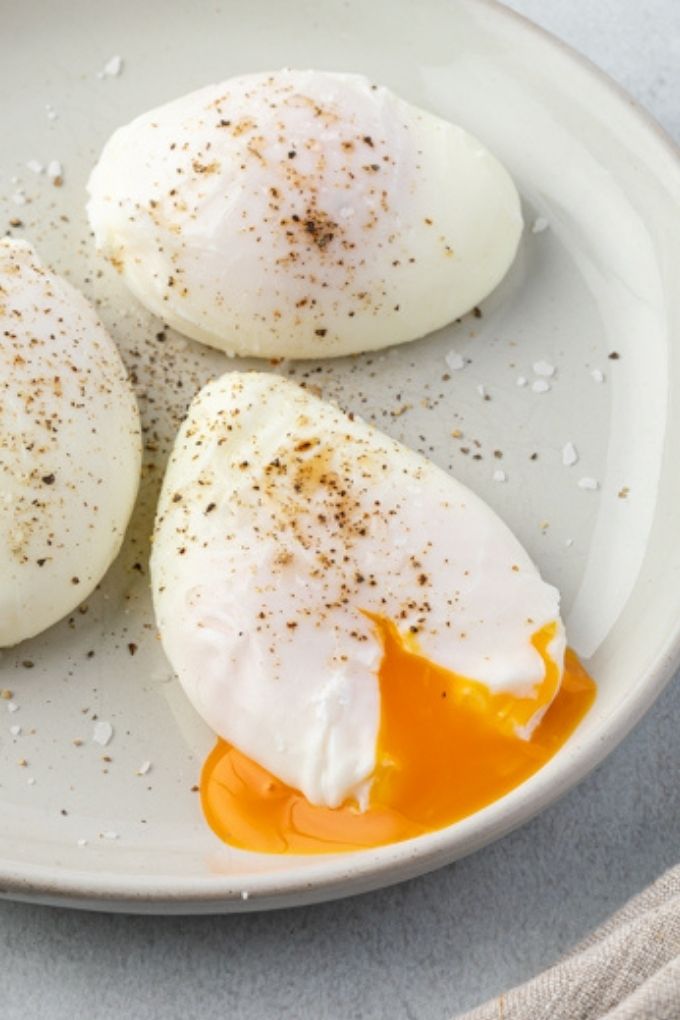
Serving suggestions
I love the versatility of poached eggs, and they have a way of giving every meal a little touch of elegance.
- Serve a poached egg atop toast or as eggs benedict for a special brunch.
- They add protein boost to grain bowls such as farro salad and quinoa salad.
- Serve over roasted sweet potatoes or air fryer potatoes with your favorite veggies for an easy vegetarian dinner.
- They’re a great low carb breakfast served with air fryer bacon and sautéed Swiss chard or your favorite greens.
Recipe tips
- Pro tip: Straining the egg in a mesh strainer removes the liquid part of the egg white, which decreases the amount of wispy egg white.
- Vinegar also helps the egg retain its shape (less wispy whites), and does not flavor the eggs. It’s important to use white vinegar as a colored vinegar will dye the egg(s).
- Use the freshest eggs possible for less wispy whites!
- Cooking times listed are for large eggs. If you’re using medium or extra large eggs, be sure to adjust the cooking time accordingly.
- Poached eggs may be made in advance. Once they’re cooked, simply cool on a plate then store in a bowl of cold water in the refrigerator for up to 2 days. Reheat them by placing them in a bowl of warm water and let stand until heated through. Remove with a slotted spoon, season with salt and pepper and serve.
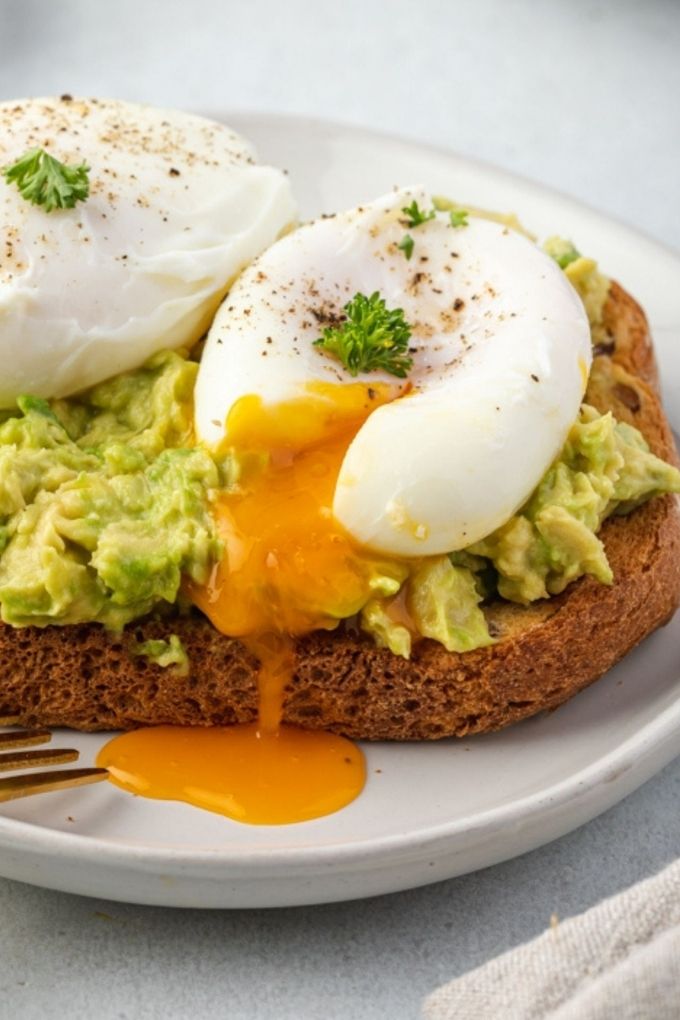
More egg recipes you’ll love:
- Bacon and egg cups
- Deviled eggs with bacon
- Egg salad
- Eggs benedict by Cooking Classy
- Spinach feta frittata
Did you try this recipe? If so, be sure to leave a review below and tag me @flavorthemoments on Facebook and Instagram
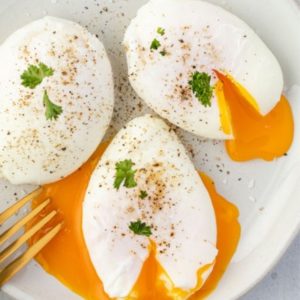
Poached Eggs Recipe
Ingredients
- 1 large egg
- 1 tablespoon white vinegar
Instructions
- Strain the egg in a mesh strainer to remove the liquid part of the egg white, then place in a ramekin or small bowl.
- Bring a medium pot of water to a boil over medium heat, then stir in the vinegar.
- Reduce the heat to low and stir the water in a circular motion to create a vortex. Gently pour the egg into the center of the vortex and stir gently once more.
- Cook the egg for 3 minutes for soft poached, 4 minutes for medium poached or 5 minutes for hard poached. Remove the egg from the pan with a slotted spoon and place on a plate. Season with salt, pepper and garnish with parsley if desired. Enjoy!
Notes
- Pro tip: Straining the egg in a mesh strainer removes the liquid part of the egg white, which decreases the amount of wispy egg white.
- Vinegar helps the egg retain its shape (less wispy whites), and does not flavor the eggs. It’s important to use white vinegar as a colored vinegar will dye the egg(s).
- Cold eggs keep their shape much better than room temperature eggs.
- Cooking times listed are for large eggs. If you’re using medium or extra large eggs, be sure to adjust the cooking time accordingly.
- Poached eggs may be made in advance. Once they’re cooked, simply cool on a plate then store in a bowl of cold water in the refrigerator for up to 2 days. Reheat them by placing them in a bowl of warm water and let stand until heated through. Remove with a slotted spoon, season with salt and pepper and serve.
Nutrition
Nutrition is estimated using a food database and is only intended to be used as a guideline for informational purposes.

